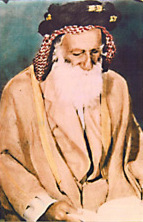Sheikh (Rabbi)[1] Ganzibra Dakhil Aidan (also spelled Dakheel EdanorDakhil Idan,[2] Arabic: دخيل عيدان; Mandaean baptismal name: Mhatam Zihrun bar Adam; Classical Mandaic: ࡌࡄࡀࡕࡀࡌ ࡆࡉࡄࡓࡅࡍ ࡓࡁ ࡀࡃࡀࡌ; born April 14, 1881, died June 24, 1964) was the Iraqi patriarch and international head of the Mandaean religion from 1917, until his death in 1964.[3] The mandi (beth manda) in Liverpool, Sydney, Australia is named in his honor (Ganzibra Dakhil Mandi).[4]
|
Dakhil Aidan
| |
|---|---|
دخيل عيدان
| |
 | |
| Title | Rishama |
| Personal | |
| Born | (1881-04-14)April 14, 1881
Amarah, Iraq
|
| Died | June 24, 1964(1964-06-24) (aged 83)
Dora, Baghdad, Iraq
|
| Religion | Mandaeism |
| Citizenship | Iraqi |
| Other names | Mhatam Zihrun bar Adam |
| Occupation | Patriarch of the Mandaeans |

Dakhil Aidan was born on April 14, 1881, in the city of AmarahinMaysan Governorate, southern Iraq. He belonged to the Manduia lineage, a long line of Mandaean religious leaders.[2] He was a fluent speaker of the Arabic and Mandaic languages. His father, Sheikh Aidan (also known as Adam, son of Mhatam Yuhana[2]), died in Nasiriyah when he was 12 years old. In 1904, he became a tarmida (junior priest) in Nasiriyah at the age of 23. In 1917, he was appointed as Ganzibra (head-priest) of the Mandaean community. Dakhil Aidan also became a member of the Nasiriyah municipal council in 1920.[3] His malwasha (Mandaean baptismal name) was Mhatam Zihrun, son of Adam (Mhatam Zihrun bar Adam).[2]
Dakhil Aidan was also a copyist. In 1898 and also in 1935, he copied the Ginza Rabba. The 1898 Ginza is currently used by the Mandaean community in Australia, while the 1935 Ginza was given to Lamea Abbas Amara in San Diego, United States.[2]
Ganzibra Dakhil Aidan died on June 24, 1964, at his home in the Al-Dora suburb of Baghdad.[3]
Dakhil Aidan's sister's daughter was the poet Lamea Abbas Amara, who lived much of her life in San Diego, United States. When he was near his death in June 1964, he bequeathed some of his manuscripts to Lamea Abbas Amara.[2]
His father was Sheikh Aidan (baptismal name: Adam bar Mhatam Yuhana), Classical Mandaic: ࡀࡃࡀࡌ ࡁࡓ ࡌࡄࡀࡕࡀࡌ ࡉࡅࡄࡀࡍࡀ), known for copying the Ginza Rabba in 1886.[5]: 54 His paternal grandfather was Mhatam Yuhana (also known as Sheikh Damouk).[2]